Effects of Hydraulic Erosion on the Spatial Redistribution Characteristics of Soil Aggregates and SOC on Pisha Sandstone Slope
Abstract
:1. Introduction
2. Materials and Methods
2.1. Overview of the Study Area
2.2. Experimental Design
2.2.1. Selection and Layout of Sample Plots
2.2.2. Terrain Monitoring
2.2.3. Soil Collection and Sample Determination
2.3. Data Processing
3. Results and Analysis
3.1. Slope Erosion Intensity Analysis
3.2. Spatial Redistribution Characteristics of Soil Aggregates
3.3. Spatial Variation Characteristics of SOC
3.4. Effects of Soil Aggregates on the Spatial Redistribution of SOC
4. Discussion
4.1. Spatial Redistribution Characteristics of Soil Aggregates under Different Erosion Intensities
4.2. Causes of Hydraulic Erosion-Induced SOC Migration
4.3. Relationship between Soil Aggregates and Spatial Redistribution of SOC
5. Conclusions
Author Contributions
Funding
Institutional Review Board Statement
Informed Consent Statement
Data Availability Statement
Acknowledgments
Conflicts of Interest
References
- Gintaras, J.; Witoniak, M.; Kinderien, I. Dynamics of slope processes under changing land use conditions in young morainic landscapes, Western Lithuania. Int. Agrophys. 2020, 1, 43–55. [Google Scholar]
- Anderson, R.; Brye, K.R.; Wood, L.S. Soil Aggregate Stability as Affected by Landuse and Soil Properties in the Lower Mississippi River Valley. Soil Sci. Soc. Am. J. 2019, 83, 1512. [Google Scholar] [CrossRef]
- Gordon, H.; Haygarth, P.M.; Bardgrtt, R.D. Drying and rewetting effects on soil microbial community composition and nutrient leaching. Soil Biol. Biochem. 2008, 40, 302–311. [Google Scholar] [CrossRef]
- Teh, C.B.S. The Stability of Individual Macroaggregate Size Fractions of Ultisol and Oxisol Soils. J. Agric. Ence Technol. 2012, 14, 459–466. [Google Scholar]
- Regina, S.; Jūratė, A.; Donata, T.; Gintaras, S. Impact of sward formation on soil organic carbon variation and relations with soil microbial activity. Zemdirb.-Agric. 2022, 109, 195–202. [Google Scholar] [CrossRef]
- Zhao, P.; Li, L.; Lin, L.; Zhai, G.; Cruse, R.M.; Wang, E. Response of surface soil nutrients and organic carbon fractions to tillage erosion vs. Water erosion in an agricultural landscape. Soil Sci. Soc. Am. J. 2022, 86, 1470–1482. [Google Scholar] [CrossRef]
- Jennifer, A.J.; Dungait, D.W.; Hopkins, A.S.; Gregory, A.P.; Whit, M. Soil organic matter turnover is governed by accessibility not recalcitrance. Global Change Biol. 2016, 18, 1781–1796. [Google Scholar] [CrossRef]
- Arunrat, N.; Sereenonchai, S.; Kongsurakan, P.; Hatano, R. Soil organic carbon and soil erodibility response to various land-use changes in northern Thailand. Catena 2022, 219, 106595. [Google Scholar] [CrossRef]
- Song, K.; Yang, J.J.; Xue, Y.; Lv, W.G.; Zheng, X.Q.; Pan, J.J. Influence of tillage practices and straw incorporation on soil aggregates, organic carbon, and crop yields in a rice-wheat rotation system. Sci. Rep. 2016, 6, 36602. [Google Scholar] [CrossRef]
- Causarano, H.J.; Doraiswamy, P.C.; McCarty, G.W.; Hatfield, J.L.; Milak, S.; Stern, A.J. EPIC modeling of soil organic carbon sequestration in croplands of Iowa. J. Environ. Qual. 2008, 37, 1345–1353. [Google Scholar] [CrossRef]
- Bronick, C.J.; Lal, R. Soil structure and management: A review. Geoderma 2005, 124, 3–22. [Google Scholar] [CrossRef]
- Wang, J.G.; Yu, B.; Ni, S.M.; Guo, Z.L.; Cai, C.F. Effects of sediment load on the abrasion of soil aggregate and hydraulic parameters in experimental overland flow. J. Integr. Agric. 2020, 19, 1117–1126. [Google Scholar] [CrossRef]
- Lal, R. Accelerated Soil erosion as a source of atmospheric CO2. Soil Tillage Res. 2019, 18, 35–40. [Google Scholar] [CrossRef]
- Berhe, A.A.; Harte, J.; Harden, J.W.; Torn, M.S. The significance of the erosion—induced terrestrial carbon sink. BioScience 2007, 57, 337. [Google Scholar] [CrossRef]
- Gao, L.Q.; Matthew, A.; Bowker Sun, H.; Zhao, J.; Zhao, Y.G. Linkages between biocrust development and water erosion and implications for erosion model implementation. Geoderma 2020, 357, 113973. [Google Scholar] [CrossRef]
- Olson, K.R.; An, G. Dynamics of soil organic carbon storage and erosion due to land use change (Illinois, USA). Eurasian Soil Sci. 2020, 53, 436–445. [Google Scholar] [CrossRef]
- Tong, L.S.; Fang, N.F.; Xiao, H.B.; Shi, Z.H. Sediment deposition changes the relationship between soil organic and inorganic carbon: Evidence from the Chinese Loess Plateau. Agric. Ecosyst. Environ. 2020, 30, 107076. [Google Scholar] [CrossRef]
- Zeng, Y.; Fang, N.F.; Shi, Z.H.; Lu, X.X.; Wang, Z.G. Soil Organic Carbon Redistribution and Delivery by Soil Erosion in a Small Catchment of the Yellow River Basin. J. Geophys. Res.-Biogeosci. 2020, 125, 1–16. [Google Scholar] [CrossRef]
- Li, L.; Qin, F.C.; Yang, X.L.; Jiang, L.N.; Dong, X.Y.; Ren, X.T. Relationship between the slope microtopography and the spatial redistribution pattern of soil organic carbon under water erosion. J. Soil Water Conserv. 2021, 76, 435–445. [Google Scholar] [CrossRef]
- Zhang, P.; Xiao, P.Q.; Yao, W.Y.; Liu, G.B.; Sun, W.Y. Analysis of complex erosion models and their implication in the transport of Pisha sandstone sediments. Catena 2021, 207, 105636. [Google Scholar] [CrossRef]
- He, H.G.; Zhang, Z.K.; Su, R.; Dong, Z.G.; Zhen, Q.; Pang, J.Y.; Lambers, H. Amending aeolian sandy soil in the Mu Us Sandy Land of China with Pisha sandstone and increasing phosphorus supply were more effective than increasing water supply for improving plant growth and phosphorus and nitrogen nutrition of lucerne (Medicago sativa). Crop Pasture Sci. 2020, 71, 785–793. [Google Scholar] [CrossRef]
- Liang, Z.S.; Wu, Z.R.; Yao, W.Y.; Noori, M.; Yang, C.Q.; Xiao, P.Q.; Leng, Y.B.; Deng, L. Pisha sandstone: Causes, processes and erosion options for its control and prospects. Int. Soil Water Conserv. Res. 2019, 7, 1–8. [Google Scholar] [CrossRef]
- Zhang, P.; Yao, W.; Liu, G.; Xiao, P.; Sun, W. Study Data from Yellow River Institute of Hydraulic Research Provide New Insights into Geomorphology (Experimental Study of Sediment Transport Processes and Size Selectivity of Eroded Sediment on Steep Pisha Sandstone Slopes). Geomorphology 2020, 363, 107211. [Google Scholar] [CrossRef]
- Kuhn, N.J.; Van Oost, K.; Cammeraat, E. Soil erosion, sedimentation and the carbon cycle Preface. Catena 2012, 94, 1–2. [Google Scholar] [CrossRef]
- Vermang, J.; Norton, L.D.; Huang, C.; Cornelis, W.M.; Silva, A.M.D. Characterization of soil surface roughness effects on runoff and soil erosion rates under simulated rainfall. Soil Sci. Soc. Am. J. 2015, 79, 903–916. [Google Scholar] [CrossRef]
- Cilek, A. Soil organic carbon losses by water erosion in a Mediterranean watershed. Soil Res. 2016, 55, 363–375. [Google Scholar] [CrossRef]
- Liang, Z.S.; Liu, H.W.; Zhao, Y.B.; Wang, Q.D.; Wu, Z.R.; Deng, L.; Gao, H.Y. Effects of rainfall intensity, slope angle, and vegetation coverage on the erosion characteristics of Pisha sandstone slopes under simulated rainfall conditions. Environ. Sci. Pollut. Res. Int. 2020, 27, 17458–17467. [Google Scholar] [CrossRef]
- Wei, S.C.; Zhang, X.P.; McLaughlin, N.B.; Chen, X.W.; Jia, S.X.; Liang, A.Z. Impact of soil water erosion processes on catchment export of soil aggregates and associated SOC. Geoderma 2017, 294, 63–69. [Google Scholar] [CrossRef]
- Ma, W.; Li, Z.W.; Ding, K.Y.; Huang, J.Q.; Nie, X.D.; Zeng, G.M.; Wang, S.G.; Liu, G.P. Effect of soil erosion on dissolved organic carbon redistribution in subtropical red soil under rainfall simulation. Geomorphology 2014, 226, 217–225. [Google Scholar] [CrossRef]
- Fullen, M.A.; Yi, Z.; Brandsma, R.T. Comparison of soil and sedimentproperties of a loamy sand soil. Soil Technol. 1997, 10, 35–45. [Google Scholar] [CrossRef]
- Martinez-Mena, M.; Castillo, V.; Albaladejo, J. Relations between interrill erosion processes and sediment particle size distribution in a semiarid Mediterranean area of SE of Spain. Geomorphology 2002, 45, 261–275. [Google Scholar] [CrossRef]
- Zhao, L.S.; Liang, X.L.; Wu, F.Q. Soil surface roughness change and its effect on runoff and erosion on the Loess Plateau of China. J. Arid. Land 2014, 6, 400–409. [Google Scholar] [CrossRef]
- Fu, Y.; Li, G.L.; Wang, D.; Zheng, T.G.; Yang, M.G. Raindrop Energy Impact on the Distribution Characteristics of Splash Aggregates of Cultivated Dark Loessial Cores. Water 2019, 11, 1514. [Google Scholar] [CrossRef]
- Aksakal, E.L.; Angin, I.; Sari, S. A new approach for calculating aggregate stability: Mean weight aggregate stability (MWAS). Catena 2020, 194, 104708. [Google Scholar] [CrossRef]
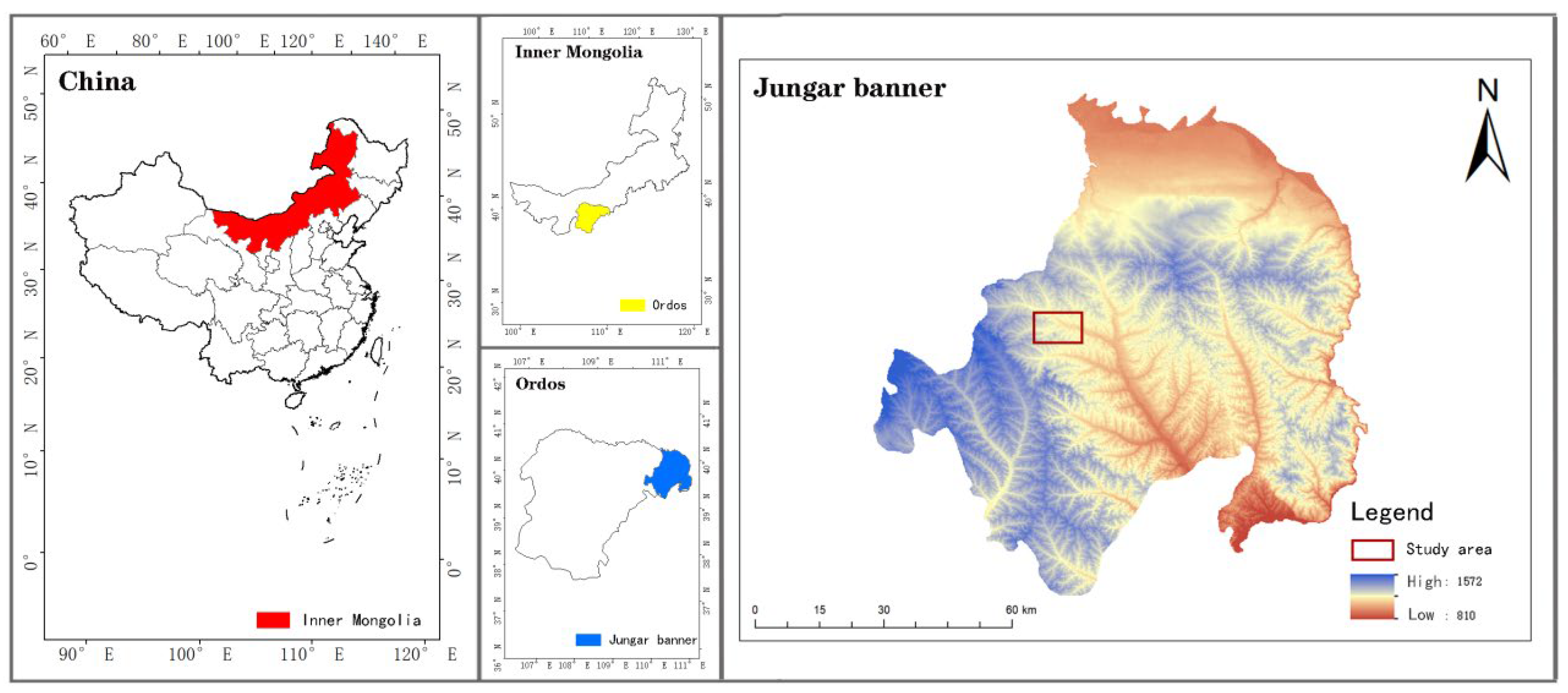
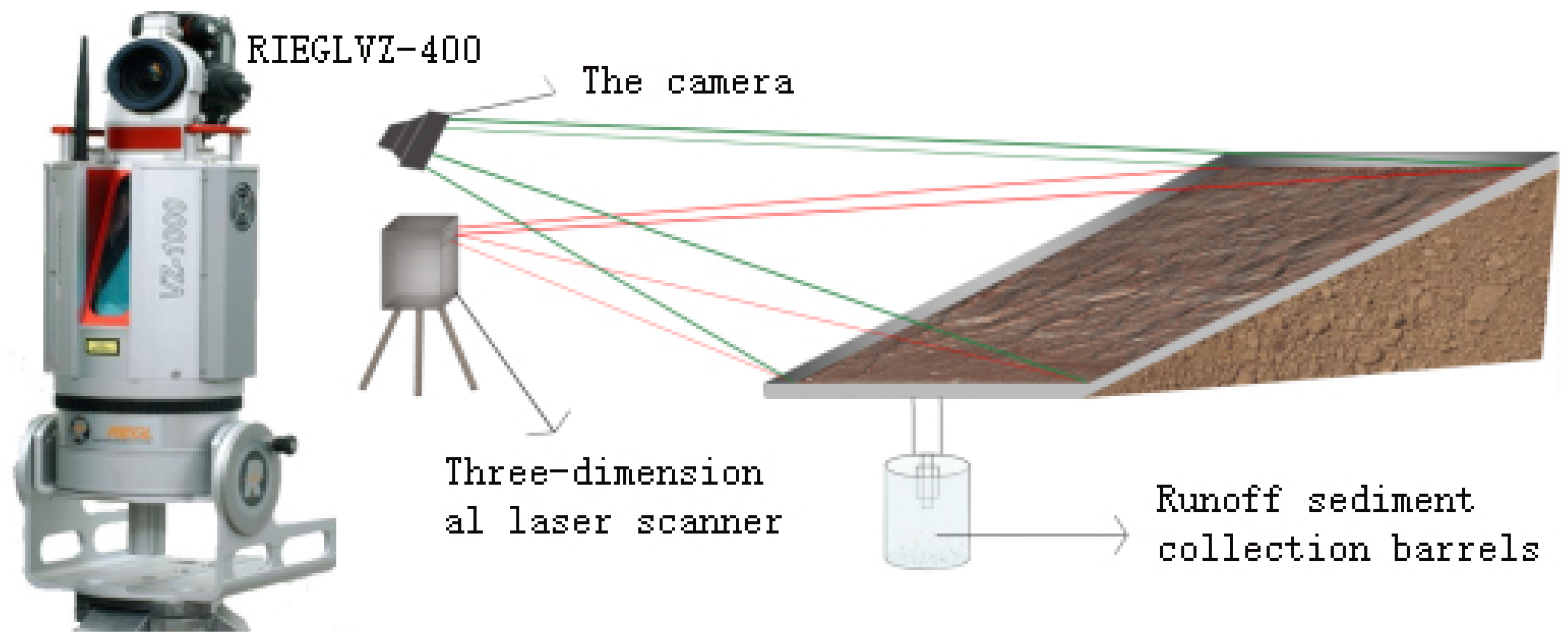

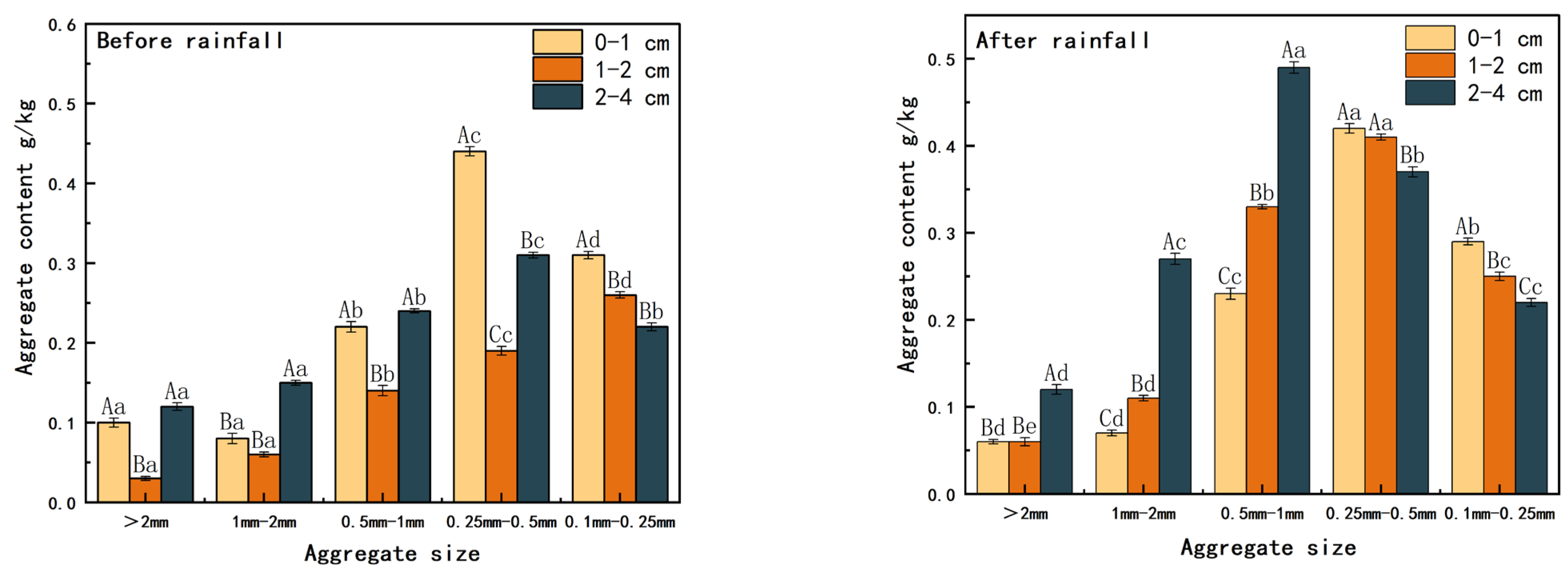


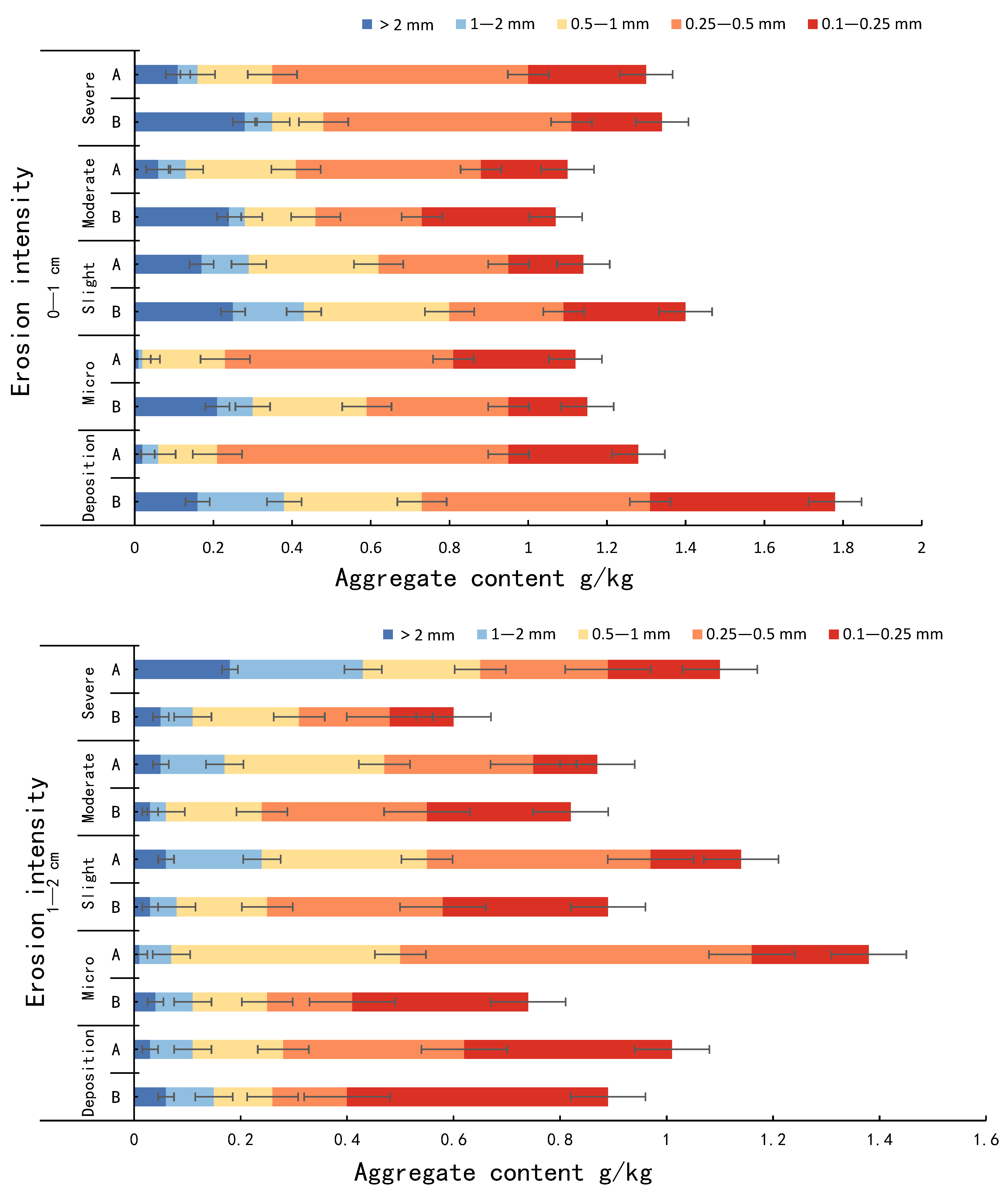


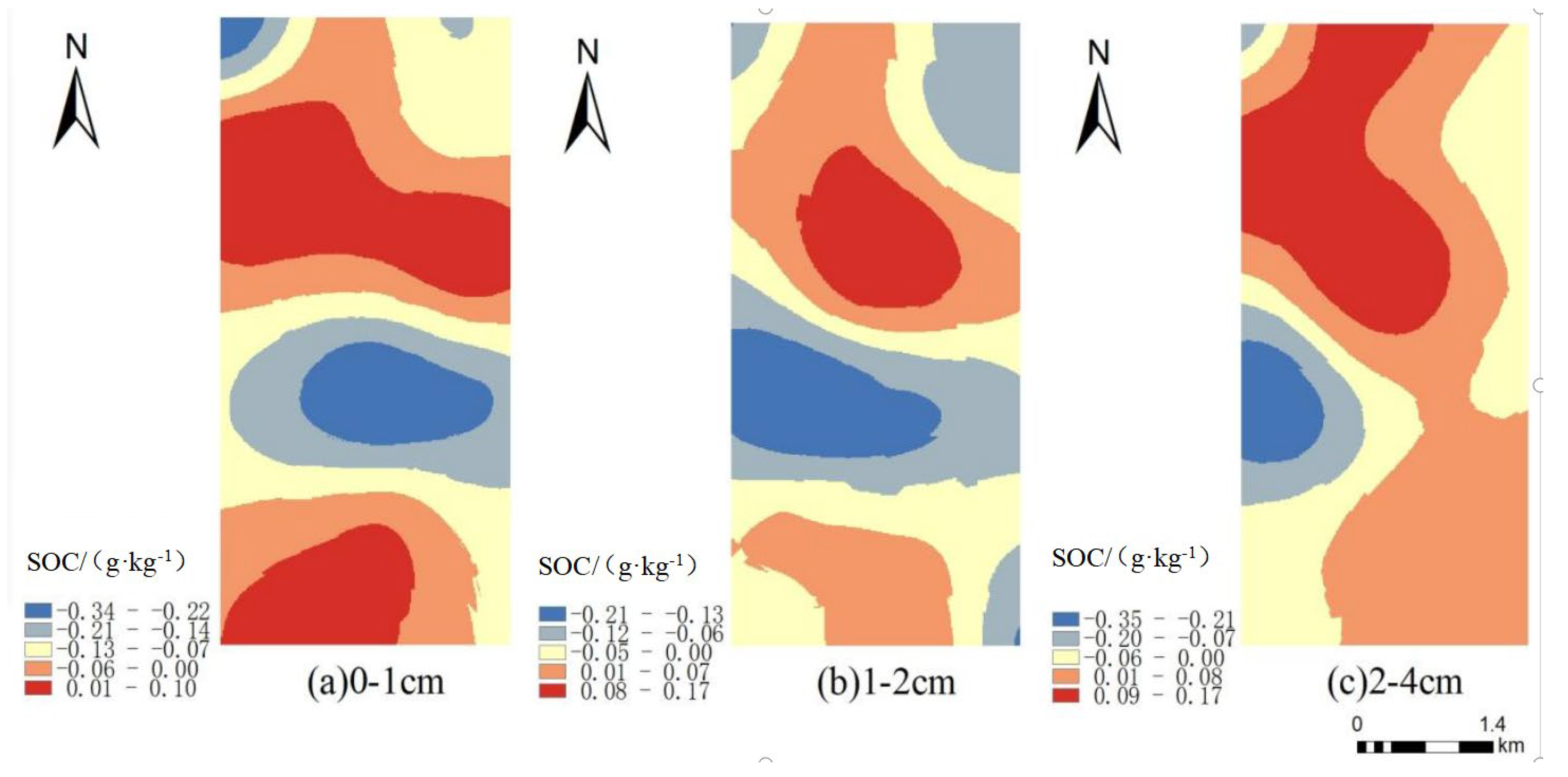

| Soil Type | Soil Composition (%) | Bulk Density (g/cm3) | Total Nitrogen (g/kg) | Total Phosphorus (g/kg) | Cation Exchange Capacity (cmol/kg) | Soil Permeability (mm/min) | ||
|---|---|---|---|---|---|---|---|---|
| Clay | Silt | Sand | ||||||
| Kastanozem | 5.22 | 51.3 | 43.48 | 1.64 | 0.41 | 1.19 | 8.26 | 0.6–1.2 |
| Rainfall Event | Erosion Depth(cm) | Non-Erosive Zone (Pixels) | Total Erosion Area (Pixels) | Proportion of Eroded Area (%) | |||
|---|---|---|---|---|---|---|---|
| 0–1 | 1–2 | 2–3 | >3 | ||||
| R1 | 15,575 | 19 | 0 | 0 | 7009 | 15,594 | 69 |
| R2 | 5219 | 0 | 0 | 0 | 17,470 | 5219 | 23 |
| R3 | 8973 | 0 | 0 | 0 | 13,748 | 8973 | 39 |
| R4 | 17,617 | 129 | 25 | 3 | 4973 | 17,774 | 78 |
| R5 | 9610 | 8 | 0 | 0 | 9274 | 9618 | 51 |
| R6 | 10,838 | 52 | 68 | 5 | 7919 | 10,963 | 58 |
| R7 | 12,347 | 67 | 0 | 0 | 6372 | 12,414 | 66.1 |
| R8 | 96 | 9 | 1 | 0 | 17,106 | 106 | 6.2 |
| R9 | 14,624 | 24 | 2 | 0 | 2575 | 14,650 | 85 |
| R10 | 4573 | 40 | 37 | 1 | 12,207 | 4651 | 27.6 |
| R11 | 6616 | 11 | 2 | 0 | 10,195 | 6629 | 39.4 |
| R12 | 10,952 | 276 | 19 | 0 | 6931 | 11,247 | 61.9 |
| R13 | 3919 | 17 | 9 | 0 | 14,206 | 3945 | 21.7 |
| Soil Layer/cm | >2 mm | 1–2 mm | 0.5–1 mm | 0.25–0.5 mm | 0.1–0.25 mm | ||
|---|---|---|---|---|---|---|---|
| Before Rainfall | 0–1 | SOC | −0.011 | −0.122 | 0.319 | 0.052 | 0.358 |
| 1–2 | −0.054 | 0.02 | −0.349 | −0.226 | 0.244 | ||
| 2–4 | −0.136 | −0.091 | −0.195 | 0.383 | 0.393 | ||
| After Rainfall | 0–1 | SOC | −0.11 | 0.062 | 0.196 | 0.117 | 0.493 * |
| 1–2 | −0.24 | −0.228 | −0.435 | −0.075 | 0.277 | ||
| 2–4 | −0.255 | −0.274 | −0.13 | 0.294 | 0.402 |
Disclaimer/Publisher’s Note: The statements, opinions and data contained in all publications are solely those of the individual author(s) and contributor(s) and not of MDPI and/or the editor(s). MDPI and/or the editor(s) disclaim responsibility for any injury to people or property resulting from any ideas, methods, instructions or products referred to in the content. |
© 2023 by the authors. Licensee MDPI, Basel, Switzerland. This article is an open access article distributed under the terms and conditions of the Creative Commons Attribution (CC BY) license (https://creativecommons.org/licenses/by/4.0/).
Share and Cite
Zhang, P.; Li, L.; Wang, J.; Zhang, S.; Zhu, Z. Effects of Hydraulic Erosion on the Spatial Redistribution Characteristics of Soil Aggregates and SOC on Pisha Sandstone Slope. Sustainability 2023, 15, 13276. https://doi.org/10.3390/su151713276
Zhang P, Li L, Wang J, Zhang S, Zhu Z. Effects of Hydraulic Erosion on the Spatial Redistribution Characteristics of Soil Aggregates and SOC on Pisha Sandstone Slope. Sustainability. 2023; 15(17):13276. https://doi.org/10.3390/su151713276
Chicago/Turabian StyleZhang, Peng, Long Li, Jing Wang, Shangxuan Zhang, and Zhizhuo Zhu. 2023. "Effects of Hydraulic Erosion on the Spatial Redistribution Characteristics of Soil Aggregates and SOC on Pisha Sandstone Slope" Sustainability 15, no. 17: 13276. https://doi.org/10.3390/su151713276
APA StyleZhang, P., Li, L., Wang, J., Zhang, S., & Zhu, Z. (2023). Effects of Hydraulic Erosion on the Spatial Redistribution Characteristics of Soil Aggregates and SOC on Pisha Sandstone Slope. Sustainability, 15(17), 13276. https://doi.org/10.3390/su151713276





